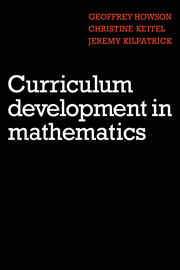Book contents
- Frontmatter
- Contents
- Preface
- 1 Curriculum development: an introduction
- 2 The historical background
- 3 Case studies of curriculum development
- 4 The practice and management of curriculum development
- 5 Curriculum theory and curriculum research
- 6 A retrospective look at curriculum projects
- 7 Evaluation within curriculum development
- 8 Lessons for today and tomorrow
- Appendix 1
- Appendix 2
- Bibliography
- Index
4 - The practice and management of curriculum development
Published online by Cambridge University Press: 05 October 2010
- Frontmatter
- Contents
- Preface
- 1 Curriculum development: an introduction
- 2 The historical background
- 3 Case studies of curriculum development
- 4 The practice and management of curriculum development
- 5 Curriculum theory and curriculum research
- 6 A retrospective look at curriculum projects
- 7 Evaluation within curriculum development
- 8 Lessons for today and tomorrow
- Appendix 1
- Appendix 2
- Bibliography
- Index
Summary
The case studies in the preceding chapter illustrate something of the variety in recent approaches to curriculum development in school mathematics. The discussion of contrasts between the three projects that was presented at the end of the chapter, however, greatly oversimplified the manifold differences to be seen in curriculum development practice. A more detailed and comprehensive view of such practice requires consideration of the many factors that operate to enhance or constrain curriculum development.
In this chapter we shall examine some factors influencing curriculum development in school mathematics. First, we shall look at curriculum development ‘from the outside in’, noting forces outside the school and the classroom that shape any efforts to change the curriculum. Then, we shall look at curriculum development ‘from the inside out’, noting problems faced by the teacher in putting new ideas into practice. Finally, we consider how curriculum development has been managed amid the welter of confusing, and sometimes conflicting, demands for an improved curriculum in school mathematics.
Forces shaping curriculum development efforts
Think of a school mathematics ‘classroom’ anywhere around the world. It may be an open-sided hut on the plains of Africa, a laboratory room in a primary school in a European city, or a group of pupils working at home in front of their television sets in the Australian outback. The teacher may have a wealth of materials for teaching, only blackboard and chalk, or nothing at all.
Information
- Type
- Chapter
- Information
- Curriculum Development in Mathematics , pp. 49 - 83Publisher: Cambridge University PressPrint publication year: 1981
